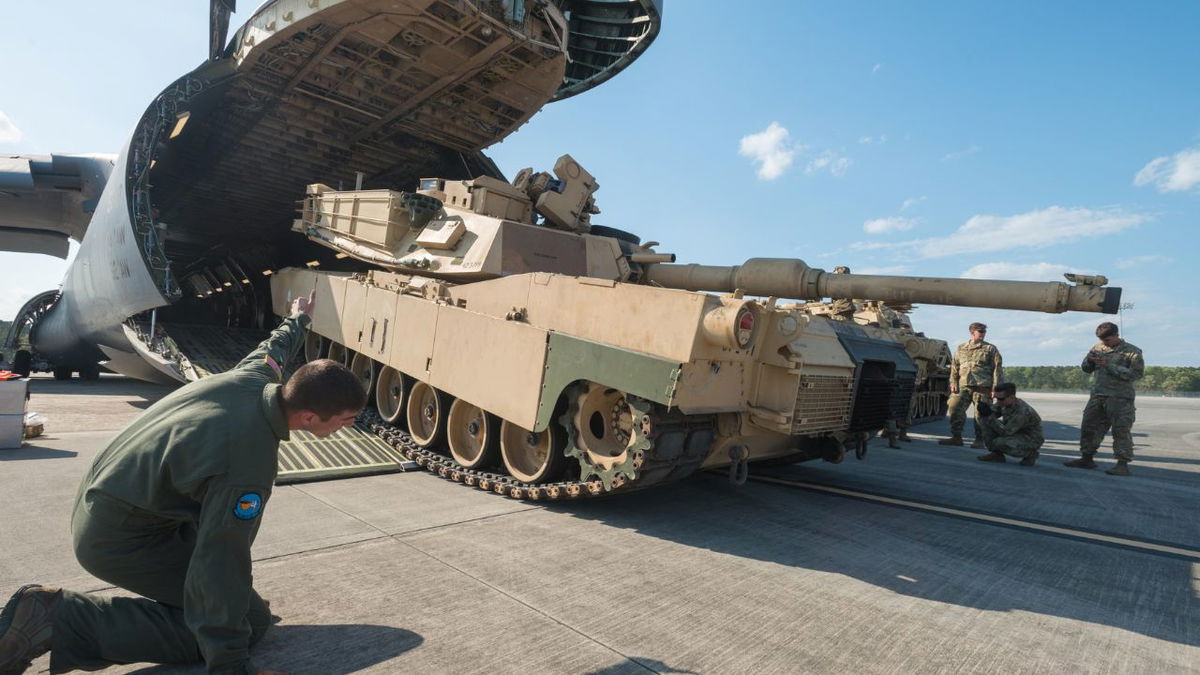US preps another major Ukraine aid package but Kyiv pleads for tanks

By Oren Liebermann and Haley Britzky, CNN
(CNN) -- The US is expected to announce one of its largest military aid packages for Ukraine in the coming days, according to two US officials familiar with the plans. But Kyiv has been pleading for modern tanks, a request the US is not yet willing to grant, despite the United Kingdom and Poland saying they will.
So far the US has appeared resistant to sending them, even though the UK and other key allies are preparing to send tanks that could make a crucial difference in the war as Kyiv braces for a possible large-scale Russian counter-offensive.
The UK has already announced it will send 12 of their Challenger 2 tanks to Ukraine, heralding a new phase in the international effort to arm Kyiv and cross what had previously appeared to be a red line for the US and its European allies.
Earlier this month, Polish President Andrzej Duda said his country would provide Ukraine with a company of Leopard tanks, while Finland said tanks are under consideration.
The US, which has led the way on providing military aid to Ukraine to combat's Russia's invasion, now appears more cautious than key allies, even as it has far outpaced other countries in sending aid to Ukraine.
The largest US security package to date, announced earlier this month, totaled more than $3 billion and included the first shipment of Bradley infantry fighting vehicles. The previous largest package was $1.85 billion and was announced in late December.
Tanks represent the most powerful direct offensive weapon provided to Ukraine so far, a heavily armed and armored system designed to meet the enemy head on instead of firing from a distance. If used properly with the necessary training, they could allow Ukraine to retake territory against Russian forces that have had time to dig defensive lines. The US has begun supplying refurbished Soviet-era T-72 tanks, but modern western tanks are a generation ahead in terms of their ability to target enemy positions.
British Foreign Secretary James Cleverly said on Tuesday that the UK decided to "intensify our support" for the Ukrainians by sending tanks and other heavy equipment because they want to send "a really clear message" to Russian President Vladimir Putin that they will support Ukraine until they are "victorious."
"It's in no one's interest for this to be a long, drawn out, attritional war," Cleverly said at the Center for Strategic and International Studies in Washington. "I mean, we seeing terrible images of civilian infrastructure, residential buildings being hit by missiles, women, children being killed, bodies being taken out of collapsed buildings. We cannot allow that to go on any longer than is absolutely necessary ... So the moral imperative is to bring this to a conclusion."
Ukraine has asked for '1%' of NATO's tanks
Ukraine has been asking for such tanks since nearly the start of Russia's invasion. President Volodymyr Zelensky famously asked for "1%" of NATO's tanks in April, but it was a weapon the West was not willing to seriously consider amid concerns of managing escalation with Russia and the time it takes to train tank operators and maintainers.
Despite Britain's change of heart, the US has not shown any indication that it's preparing to send its M-1 Abrams tank. It has acknowledged a willingness to consider sending modern tanks, but they have been floated as a long-term option. But critics say the time is now as Ukraine braces for the possibility Russia will mobilize more troops and launch a new offensive. It would take weeks to train Ukrainian troops to use the Abrams effectively, so the window for a spring deployment is closing rapidly.
Retired Army Gen. Robert Abrams -- the former commander of US Forces Korea whose father was the namesake for the tank -- told CNN that "the longer we delay a decision, and the longer we slow-roll this, we're taking away valuable time."
"If in the end, five months from now we say, 'Okay fine, we're going to give them some M1 tanks, choose your variety' -- we've just lost five months of prep time. So the politics decision actually has to come sooner rather than later," he said.
On Tuesday, US Secretary of State Antony Blinken said that the support Washington has provided to Kyiv has evolved throughout the course of the war and teased more announcements as he reiterated that the United States is determined to give Ukraine "what it needs to succeed on the battlefield."
Speaking alongside Cleverly, Blinken praised the UK's decision to send tanks. "We applaud the prime minister's commitment over the weekend to send Challenger 2 tanks and additional artillery systems to Ukraine, elements that will continue to reinforce and add to what the United States has provided, including in our most recent drawdown."
But so far, no US official has signaled the administration is likely to change its mind and send American tanks.
The Pentagon says it's not a question of managing escalation with Russia or questions over heavy US weaponry falling into Russian hands. The concern is how difficult it is to operate and maintain the Abrams tank and whether the 70-ton tank would work for Ukrainian forces.
"It is a very, very different system than the generation of tank they're currently operating," said retired Army Maj. Gen. Patrick Donahoe, former commander of the Army's Maneuver Center of Excellence at Fort Benning, Georgia. "So we would have to go through a sizeable training program with their Army. It would not be something that you can just, 'Hey we field Abrams to you today and you're fighting with it tomorrow.' That's not even in the realm of the possible."
Similar to the Patriot missile system training that Ukrainians are now beginning in Oklahoma, the Abrams tank would not be an overnight fix -- on top of significant maintenance and logistics challenges, Ukrainians would also need to undergo more training to learn how to use and maintain the Abrams.
Recent announcements show how far the US and its allies have come within a short period, from a focus on the HIMARS and howitzers they have already provided to heavy armor, marking a "substantive" change in the types of offensive weaponry heading for Ukraine that will give their military "much more capability."
Aim is to make Ukraine 'more deadly on the battlefield'
"We are attempting to help Ukraine transform as fast as they can into better, capable, newer advanced weapons systems that are more deadly on the battlefield," said retired Lt. Gen. Mark Hertling. But he warned that such an effort requires a massive military infrastructure to support it with people, parts and supplies in place.
Only days earlier, before Poland said it would send tanks, the US announced that it would ship Ukraine Bradley infantry fighting vehicles for the first time -- not tanks, but "tank killers," the Pentagon said -- as France and Germany promised to send own their versions of the armored vehicle.
The coordinated announcements from Washington and Berlin, as well as the Paris announcement shortly thereafter, underscore how the US and its NATO allies have moved forward largely in unison on the issue of advanced and heavy weaponry. Instead of a single country unilaterally stepping out far ahead of others, the alliance has stayed in close coordination, using the monthly Ukraine Contact Group meetings to find and organize shipments of weapons.
All eyes will be on the next such meeting, occurring in Germany on Friday, as top officials meet to discuss what else should be provided to the embattled country.
The UK can send its Challenger 2 tank to Ukraine on its own, but Poland acknowledged it requires approval from Berlin before exporting its German-made Leopard tanks. A spokeswoman for Germany's government, Christiane Hoffmann, said last week they had received no such request from Poland or Finland. Hoffmann added that Germany is in close contact with the US, France, the UK, Poland and Spain about ongoing military assistance to Ukraine.
Germany on Tuesday signaled a reluctance to approving the shipments unless the US sends its own tanks.
"We are never going alone, because this is necessary in a very difficult situation like this," said German Chancellor Olaf Scholz.
If Germany offered approval for countries to send Leopard tanks to Ukraine, it would open up a previously off-limits cache of potential arms for Kyiv. About a dozen European countries operate the Leopard, which could provide Ukraine with an abundance of potential ammo and spare parts, as well as additional tanks once Ukrainian forces become familiar with the Leopard.
While the Ukrainians welcomed the UK's decision to send Challenger 2 tanks, experts cautioned that too many tank variants would only stretch Ukraine thinner on its ability to maintain them.
"The more variations of tanks that you put into the Ukrainian Army, it's going to challenge their logistics more and more," said Donahoe. "I mean the Challenger is a completely different system than the [US-made] Abrams and a completely different system than the Leopard ... There's significant challenges with them integrating Challenger as well if they're going to get more variants of other westerns [main battle tanks]."
The-CNN-Wire
™ & © 2023 Cable News Network, Inc., a Warner Bros. Discovery Company. All rights reserved.



